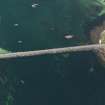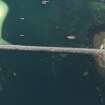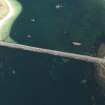Pricing Change
New pricing for orders of material from this site will come into place shortly. Charges for supply of digital images, digitisation on demand, prints and licensing will be altered.
Upcoming Maintenance
Please be advised that this website will undergo scheduled maintenance on the following dates:
Thursday, 9 January: 11:00 AM - 3:00 PM
Thursday, 23 January: 11:00 AM - 3:00 PM
Thursday, 30 January: 11:00 AM - 3:00 PM
During these times, some functionality such as image purchasing may be temporarily unavailable. We apologise for any inconvenience this may cause.
Empire Seaman: East Weddell Sound, Scapa Flow, Orkney
Craft (20th Century), Obstruction (Period Unassigned), Steamship (20th Century)
Site Name Empire Seaman: East Weddell Sound, Scapa Flow, Orkney
Classification Craft (20th Century), Obstruction (Period Unassigned), Steamship (20th Century)
Alternative Name(s) Morea; East Weddel Sound; Churchill Causeway; Churchill Barrier No. 3; North Sea; Empire Seaman; Empire Seaman (Ex. Morea)
Canmore ID 102182
Site Number ND49NE 8001
NGR ND 47274 98538
Datum WGS84 - Lat/Long
Permalink http://canmore.org.uk/site/102182
- Council Orkney Islands
- Parish Maritime - Orkney
- Former Region Orkney Islands Area
- Former District Maritime
- Former County Not Applicable
ND49NE 8001 4725 9855
N58 52.29 W2 54.885
NLO: Weddell Sound [name centred ND 477 988]
Stromness [name: HY 253 090]
Scapa Flow [name centred HY 36 00].
Formerly entered as ND49NE 8718.
For adjacent and successor causeway (Churchill Barrier no. 3), see ND49NE 16.
For other blockships in this group, see ND49NE 8010-13.
For plan indicating the relative locations and orientations of blockships in this group, see Macdonald 1990, 125.
Horizontal Datum = OGB
Buoyage =
Circumstances of Loss Details
-----------------------------
The EMPIRE SEAMAN was a steel single-screw steamship, built in 1922. It was seized by the Royal Navy as a war prize to be sunk in East Weddel Sound as a blockship.
Source; Wrecks of Scapa Flow.
Surveying Details
-----------------------------
14 March 1972. A position of 58 52 15N, 002 54 56W, or bearing 190 degree, 624 metres from Glimp Holm trig station (97) was given. The vessel is lying with its keel on an orientation of approximately 135/315 degrees. The stern and bows have been cut off and removed, also the engines and fittings. Only an empty shell remains standing in 6 metres of water, proud of the surface, and in a very strong state.
Report by Undermarine Operations, 5 march 1972.
2 March 1976. There are two large rectangular blocks of wreckage centred on 58 52 17.4N, 002 54 53.1W. Each block about 10 x 60 metres and are about 50 metres apart. The two blocks are end to end, and orientated 111/291 degrees. Both show above the level of mean low water.
Source: Ordnance Survey aerial photography dated 16 May 1973.
28 August 1992. Only the midship section remains. The bow and stern have been cut off and removed together with the engines. The midship area is very broken up, with only a few sections of plating exposed at high water. The prop shaft and rudder can be clearly seen. South of the prop shaft, the engine room area has been blasted open and no longer has a recognisable ship shape. However, much of the original engine equipment is still lying around. Two large boilers and a length of huge camshaft rise from the seabed. Steering gear lies on the seabed. A funnel has collapsed but still has remnants of the brass steam whistle in place.
Source: Macdonald 1990
Hydrographic Office, 1995.
(Classified as steel steamship: former name cited as Morea, and date of loss 30 June 1940). Empire Seaman: this vessel was scuttled as a blockship. She was also reported as sunk, through unknown cause, on 4 December 1940.
Registration: British. Built 1922. 1927grt. Length: 88m. Beam: 12m.
(Location of loss cited as N58 52.28 W2 54.88).
I G Whittaker 1998.
Field Visit (August 1997)
Throughout the two World Wars Scapa Flow served as the base of the British Home Fleet. Access to these waters was guarded by a series of coastal batteries, booms and blockships. The blockships comprised old and damaged vessels which were deliberately sunk in position so as to form a submarine obstacle to deter enemy incursions. By 1943, the completion of the Churchill barriers, which cut off the eastern approaches to Scapa Flow, rendered the blockships obsolete. After 1945 some of the blockships were dispersed by explosive to clear the shipping lanes while many others were salvaged for parts and metal. The wrecks of several blockships remain on the sea bed and in the inter tidal zone.
(i) To the E side of Churchill Barrier #3, the wreck of the Reginald (ND 49 NE 8010) lies in shallow water. This 930 tons iron three-masted motor schooner was built in 1878 in Glasgow and was sunk in 1915. The stern section of the hull is visible above the water line.
(ii) The Lapland (ND 49 NE 8013), a 1,234 ton steel single-screw steamer was built in Dundee in 1890 and registered in Liverpool. Little of this blockship is now visible, since the barrier was constructed over it.
(iii) The Gartshore (ND 49 NE 8012), a 1,564 tons iron single-screw steamer, was built and registered in South Shields. She lies to the W side of the barrier.
(iv) The Martis (ND 49 NE 8011), a 2,483 ton steel single-screw steamer, was built in South Shields in 1894. She lies to the W side of the barrier.
(v) The Empire Seaman (ND 49 NE 8001) )was a steel single-screw steamer of 1,921 tons. Built in Lubeck in 1922, she was seized by the Royal Navy in 1940 and sunk as a blockship. She lies to the W side of the barrier.
Moore and Wilson, 1997
Coastal Zone Assessment Survey
Reference (2011)
Whittaker ID : 2551
Name : EMPIRE SEAMAN (EX. MOREA)
Latitude : 585217
Longitude : 25453
Date Built : 1922
Registration : BRITISH
Type : SS (STEEL)
Tonnage : 1927
Tonnage Code : G
Length : 88
Beam : 12
Draught : 5m
Position : Exact Position
Loss Day : 30
Loss Month : 6
Loss Year : 1940
Comment : Scuttled as a blockship. Also reported sunk, cause unknown, on 4/12/1940.
Reference (19 April 2012)
UKHO Identifier : 001258
Feature Class : Obstn
State : LIVE
Classification : Unclassified
Position (Lat/long) : 58.87098,-2.91604
Horizontal Datum : ETRS 1989
WGS84 Position (Lat/long) : 58.87098,-2.91604
WGS84 Origin : Block Shift
Previous Position : 58.87098,-2.91528
Position Method : Differential Global Positioning System
Position Quality : Unreliable
Drying Height : 1.4
Depth Quality : Least depth known
Water Depth : 5
Water Level Effect : Covers and uncovers
Vertical Datum : Lowest Astronomical Tide
Name : EMPIRE SEAMAN
Type : BLOCKSHIP
Flag : BRITISH
Tonnage : 1921
Tonnage Type : Gross
Date Sunk : 30/06/1940
Contact Description : Notable debris
Original Sensor : Reported Sinking
Last Sensor : Acoustic Sensor
Original Detection Year : 1940
Last Detection Year : 2010
Original Source : Other
Last Source : Survey Vessel
Circumstances of Loss : **STEEL SINGLE-SCREW SS, BUILT 1922, SEIZED BY ROYAL NAVY AS A WAR PRIZE & SUNK IN EAST WEDDEL SOUND AS A BLOCKSHIP. (WKS OF SCAPA FLOW).
Surveying Details : **H2496/72 14.3.72 POSN 585215N, 025456W, 190DEG, 2050FT FROM GLIMP HOLM TRIG STN (97). LYING APPROX NW/SE. STERN AND BOWS CUT OFF AND REMOVED, ALSO ENGINES & FITTINGS. EMPTY SHELL STANDING IN 20FT. PROUD OF SURFACE AND IN A VERY STRONG STATE. (UNDERMARINE OPERATIONS 5.3.72). INS AS DWP. BR STD.
**H1270/76 2.3.76 TWO LARGE RECTANGULAR BLOCKS OF WRECKAGE CENTRED ON 585217.4N, 025453.1W. EACH BLOCK ABOUT 10 X 60MTRS AND BOTH ABOUT 50MTRS APART. THE TWO BLOCKS ARE END TO END AND ORIENTATED 111/291DEG. BOTH SHOW ABOVE THE LEVEL OF MLW. (ORDNANCE SURVEY AERIAL PHOTOGRAPHY 73/137 DTD 16.5.73 FOR PG 1428-LP1). AMEND POSN. NC 2162.
**3.7.80 COVERED BY LEGEND: 'OBSTRUCTIONS' ON NCS 35, 2162.
**28.8.92 ONLY MIDSHIP SECTION REMAINS, BOW & STERN CUT OFF & REMOVED TOGETHER WITH ENGINES. MIDSHIP AREA VERY BROKEN UP WITH ONLY A FEW SECTIONS OF PLATING ARE EXPOSED AT HW. PROP SHAFT & RUDDER CAN BE CLEARLY SEEN. S OF PROP SHAFT THE ENGINE ROOM AREA HAS BEEN BLASTED OPEN, NO LONGER HAVING RECOGNISABLE SHIP SHAPE, BUT MUCH OF ORIGINAL ENGINE EQUIPMENT STILL LYING AROUND. TWO LARGE BOILERS & A LENGTH OF HUGE CAMSHAFT RISE FROM SEABED. STEERING GEAR LIES ON THE SEABED & FUNNEL HAS COLLAPSED BUT STILL HAS REMNANTS OF BRASS STEAM WHISTLE IN PLACE. (DIVE SCAPA FLOW - R MACDONALD).
POSITIONS BELOW THIS POINT ARE IN DEGREES, MINUTES AND DECIMALS OF A MINUTE
**5.10.10 LOCATED IN 5852.2590N, 0254.9623W [WGD]. LEAST M/B DEPTH DRIES 1.39MTRS. (FATHOMS LTD, POST SDC BATHY REPROCESSING). DATA NOISY AND COVERAGE POOR. AMEND POSN. COVERED BY LEGEND: 'OBSTRUCTIONS'. NCA.
Charting Comments : POSN FOR FILING ONLY
Date Last Amended : 11/10/2010
Date Position Last Amended : 11/10/2010
Reference (March 2012)
Sitename : Empire Seaman: East Weddell Sound, Scapa Flow, Orkney
Source :
Scapa Flow East in WGS1984 at 2m resolution Bathymetry Id 2010-27833_ScapaFlowArea2a_2m_SB_WGS84.bag,Fathoms Ltd,2010
Project (2013 - 2014)
The Scapa Flow 2013 Marine Archaeology Survey Project, commissioned by Historic Scotland, undertook remote sensing surveys and archaeological diving evaluations at some of the sites within Scapa Flow, Orkney and at the Churchill Barriers.
The project aimed to establish or confirm the identification, extent of survival, character and condition of around 28 known but mostly poorly recorded First and Second World War wreck sites, 8 salvage sites, several sites thought to be associated with Second World War Boom Defences, and a limited sample of geophysical features identified in previous studies (Project Adair).
The work built on that of previous surveys including those completed as part of the ScapaMap Project (2001 and 2006) and by Wessex Archaeology Scapa Flow Wrecks Survey (2012), amongst others.
The project was completed by ORCA Marine and SULA Diving
Diver Inspection (2013)
58 52.259 N 2 54.962 W The remains of a partially broken vessel measuring approximately 63m long by 15m beam lie on rocky bottom in about 6m of water. The debris can be affected by slight swells but is generally sheltered from tide.
The wreck is oriented east to west with what would have been the stern to the west. Several large sections of wreckage are visible above the water at low tide. The submerged debris has a moderate coverage of short animal turf. The propeller was not observed to the stern end, but the propeller shaft tunnel forms part of the intact remains and includes the propeller shaft and a bench. Outwith the visible intact structure, the remains are well broken down with miscellaneous debris including a
valve and cylinder, various pipework and gratings and a section of mast were visible within these remains.
To the east of the remains, there is a large pile of steel wire. An abandoned creel and several modern lines were entangled within the wreckage.
Analysis
Historical documents and images confirm that these are the remains of the SS Empire Seaman (Plate 14). The bow, stern and superstructure were salvaged by Metal Industries in the 1940s (Wood 2008).
Built as the SS Morea for Hamburg-Amerika Linie (Deutsche Levante Linie),
Hamburg by Schiffs. u. Dockbau Flender A.G., Lübeck in 1922, this German steel steamship was captured by the HMS Hasty on 12th February 1940, while trying to reach Germany from Vigo. The vessel was taken as a prize by Ministry of Shipping (R. W. Jones & Co., mgrs.), London and was renamed the SS Empire Seaman.
Purchased by the Admiralty the vessel was sunk as a blockship in East Weddel Sound on 30th June 1940.
Information from Annalisa Christie, Kevin Heath and Mark Littlewood (ORCA) March 2014
Side Scan Sonar Survey (2013)
58 52.259 N 2 54.962 W The site was assessed by side scan surveys using a pole-mounted towfish. The exposure of the remains above the water made scanning the site difficult and the images of the remains are not very clear.
Information from Annalisa Christie, Kevin Heath and Mark Littlewood (ORCA) March 2014




































